
Quick Tips
- Read any cleaning directions and gather necessary gear.
- The first step in cleaning suede is working the nap up nice and fuzzy.
- Use a suede eraser, crepe rubber, or a pencil to remove marks, shine, and some dry stains.
- Many people want to learn how to clean suede that has gotten wet or has water marks.
- For fresh, pernicious stains such as ink, oil, food, or blood (I hope not), first blot up the excess liquid.
- Protect your suede with a spray-on product designed for suede and leather.
Owning suede is sort of like dating the prom queen; it looks and feels great, but it’s high maintenance. I’m sure we can take this metaphor even further. Suede, like prom queens, is made from the hides of lamb, goats, deer, and calves. What separates suede from full-grain leather (and prom queens from common royalty) is suede’s nappy finish, which is the result of the part of the hide used and finishing techniques. Suede is softer and more flexible (sexy) than full-grain leather. Suede is as soft as Jimmy Carter’s foreign policy. Try getting naked and throwing yourself on a quality suede sofa—it’s back-inside-the-womb softness. This softness, mind you, comes at a price. Suede’s nappy, textured finish is parched for moisture and grime—it gets as dirty as that prom queen after 36 rounds of peach Schnapps (metaphor complete).
Because suede is high maintenance, I would urge consumers not to purchase an authentic suede sofa, jacket, purse, shoes, or upholstery if you have young or awkward children; a slobbery, disobedient K-9; or if you yourself are slobbery. Cleaning suede at home does have its limits—if your suede becomes too soiled or stained, you’ll need to visit the dry cleaners or call in professionals—and you’re looking at around a $100 fee for suede shoes, jackets, hats, bags, gloves, etc. Furniture would be much more. Not all suede is prepared the same, either, and much of what is out there is actually imitation suede—dubbed suede merely because of the nappy finish. Some synthetic suede types are actually easier to clean, but you have to do it right. This is why it is important to READ THE MANUFACTURER’S DIRECTIONS before cleaning or using protective products. Using the wrong technique on suede can render professional help impossible, and so below you’ll find some tried and true, conservative methods to clean suede shoes, jackets, sofas, or any other type of suede you own.
How to Clean Suede Safely
- Read any cleaning directions and gather necessary gear. Any cleaning directions on your item will tell you how to clean suede using cleaning products that are safe for use with your suede and its particular finish. Depending on the mess you’re dealing with, you may also need a blade or knife, a suede brush (a nylon nail brush or toothbrush will do), and crepe rubber or a #2 pencil. You may also need a bath towel, low-grade sand paper . . . as you can see, the tools are diverse depending on what you’re dealing with, but combined they would still be cheaper than dry cleaning.
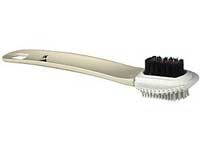 The first step in cleaning suede is working the nap up nice and fuzzy. This can be done with a dry bath towel, nail brush, or toothbrush. Investing in a suede brush is a good idea, considering suede is expensive and suede brushes are not. If you are working with shoes, you can use the metal side of a suede brush or the low-grade sandpaper. If the nap is matted down smooth, you’ll want to use the sandpaper, or even a blade, to resurrect the nap.
The first step in cleaning suede is working the nap up nice and fuzzy. This can be done with a dry bath towel, nail brush, or toothbrush. Investing in a suede brush is a good idea, considering suede is expensive and suede brushes are not. If you are working with shoes, you can use the metal side of a suede brush or the low-grade sandpaper. If the nap is matted down smooth, you’ll want to use the sandpaper, or even a blade, to resurrect the nap.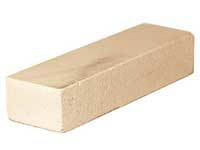 Use a suede eraser, crepe rubber, or a pencil to remove marks, shine, and some dry stains. The suede eraser works great, and they only cost a few dollars. Whatever you use, start out gently and add pressure as needed. If dealing with grime or stains, you’ll be able to see the marks actually lift off of the suede and onto the rubber—even marks that have been ground deep into the suede. When finished, use the suede brush or bath towel to work the nap back into its unbridled glory.
Use a suede eraser, crepe rubber, or a pencil to remove marks, shine, and some dry stains. The suede eraser works great, and they only cost a few dollars. Whatever you use, start out gently and add pressure as needed. If dealing with grime or stains, you’ll be able to see the marks actually lift off of the suede and onto the rubber—even marks that have been ground deep into the suede. When finished, use the suede brush or bath towel to work the nap back into its unbridled glory.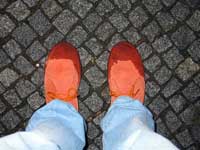 Many people want to learn how to clean suede that has gotten wet or has water marks. If the suede is recently wet, let it dry and then try using the suede brush or bath towel. If the water marks are old (most common with suede shoes), one method to try is rewetting the whole item with a spray bottle and then sponging off excess moisture. When the suede dries, the trouble spot should blend with the rest of the suede. If you get suede shoes wet, insert crumpled paper to maintain shape as they dry.
Many people want to learn how to clean suede that has gotten wet or has water marks. If the suede is recently wet, let it dry and then try using the suede brush or bath towel. If the water marks are old (most common with suede shoes), one method to try is rewetting the whole item with a spray bottle and then sponging off excess moisture. When the suede dries, the trouble spot should blend with the rest of the suede. If you get suede shoes wet, insert crumpled paper to maintain shape as they dry.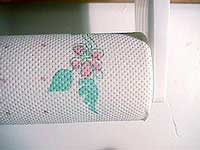 For fresh, pernicious stains such as ink, oil, food, or blood (I hope not), first blot up the excess liquid. This should be done with extreme care; using too much force will push the stain deep into the suede’s pores. Let the suede dry, and then attack the enemy with a suede eraser and suede brush. If that fails, try the sandpaper. If your suede product came with instructions on how to clean suede, they will more than likely have certain suede degreasers and cleaners in mind for this kind of disaster.
For fresh, pernicious stains such as ink, oil, food, or blood (I hope not), first blot up the excess liquid. This should be done with extreme care; using too much force will push the stain deep into the suede’s pores. Let the suede dry, and then attack the enemy with a suede eraser and suede brush. If that fails, try the sandpaper. If your suede product came with instructions on how to clean suede, they will more than likely have certain suede degreasers and cleaners in mind for this kind of disaster.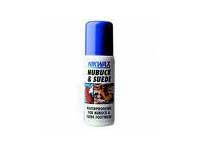 Protect your suede with a spray-on product designed for suede and leather. This is absolutely paramount. There are many “how to clean suede” pages on the web with differing strategies, but one thing they all agree on is that prevention and maintenance are vital. Many stains and marks, once set, are impossible to remove. Most stain and waterproofing sprays should be reapplied every six months. Suede should also be brushed on a regular basis to keep the nap lively and magnificent.
Protect your suede with a spray-on product designed for suede and leather. This is absolutely paramount. There are many “how to clean suede” pages on the web with differing strategies, but one thing they all agree on is that prevention and maintenance are vital. Many stains and marks, once set, are impossible to remove. Most stain and waterproofing sprays should be reapplied every six months. Suede should also be brushed on a regular basis to keep the nap lively and magnificent.
How to Clean Suede: Last Resorts
If you tried to clean suede with the above steps and that didn’t work, it’s time to take your suede to a professional. However, even professionals fail to get the job done from time to time, and perhaps you don’t have the cash flow to go in the first place. Below you’ll learn how to clean suede using some experimental methods against stains, debris, and filth. Be sure to test any of these methods in an inconspicuous area on the suede first to see how the suede—with its particular finish—reacts.
- White vinegar is a popular way to clean suede. Use a damp cloth, cotton balls, or cotton swabs to gently massage the offending area, and then let it dry. Follow up with a nylon brush or suede brush.
- Bread, stale or fresh, is used by some to clean stains from suede. Some swear by it, but it seems like a poor-man’s suede eraser to me, except that bread is more expensive.
- Your freezer is a great tool for cleaning wax from suede. This seems to be a common problem; it’s as if the same sentiments that lead people to purchase suede also cause them to roughhouse by candlelight. Stick your suede jacket, gloves, etc., in the freezer until you can break off the wax and comb out the small stuff with a suede brush.
- Windex, which I never use to clean windows, has been used successfully by many to remove fresh ink from suede furniture.
Natural Cleaning Products
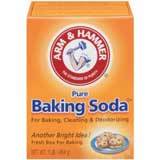 If your suede stinks, baking soda is the answer, as it absorbs acidic, nasty smells. Forget chemical sprays and deodorants—they could potentially harm the finish on your suede. For suede shoes, leave some baking soda in them overnight and remove in the morning. For a suede sofa, sprinkle some over the surface and vacuum in the morning. For a stinky suede jacket, dump baking soda in a garbage bag and throw the jacket in, shake it up, and leave it overnight.
If your suede stinks, baking soda is the answer, as it absorbs acidic, nasty smells. Forget chemical sprays and deodorants—they could potentially harm the finish on your suede. For suede shoes, leave some baking soda in them overnight and remove in the morning. For a suede sofa, sprinkle some over the surface and vacuum in the morning. For a stinky suede jacket, dump baking soda in a garbage bag and throw the jacket in, shake it up, and leave it overnight.
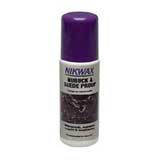 Water and stain repellent sprays are a must for suede footwear. Prevention is key when cleaning suede, and buying a suede or leather spray is much, much cheaper than any professional services. Most suede stain repellents must be reapplied every six months or so, but if you live in an unpredictable or hateful climate, you may want to do it every four to five.
Water and stain repellent sprays are a must for suede footwear. Prevention is key when cleaning suede, and buying a suede or leather spray is much, much cheaper than any professional services. Most suede stain repellents must be reapplied every six months or so, but if you live in an unpredictable or hateful climate, you may want to do it every four to five.
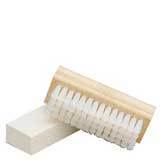 Many suede cleaning kits come with a suede eraser and a suede brush. Some suede brushes are simple, like the one pictured. Others come with different brush heads for multiple nap types and mess severities. Suede erasers work by taking the stains from the suede to the eraser. Suede erasers are less likely to further grind in stains than pencil erasers. You can get something a bit more complicated, if you so choose, like the Gear Aid ReviveX Care Kit from Amazon.
Many suede cleaning kits come with a suede eraser and a suede brush. Some suede brushes are simple, like the one pictured. Others come with different brush heads for multiple nap types and mess severities. Suede erasers work by taking the stains from the suede to the eraser. Suede erasers are less likely to further grind in stains than pencil erasers. You can get something a bit more complicated, if you so choose, like the Gear Aid ReviveX Care Kit from Amazon.